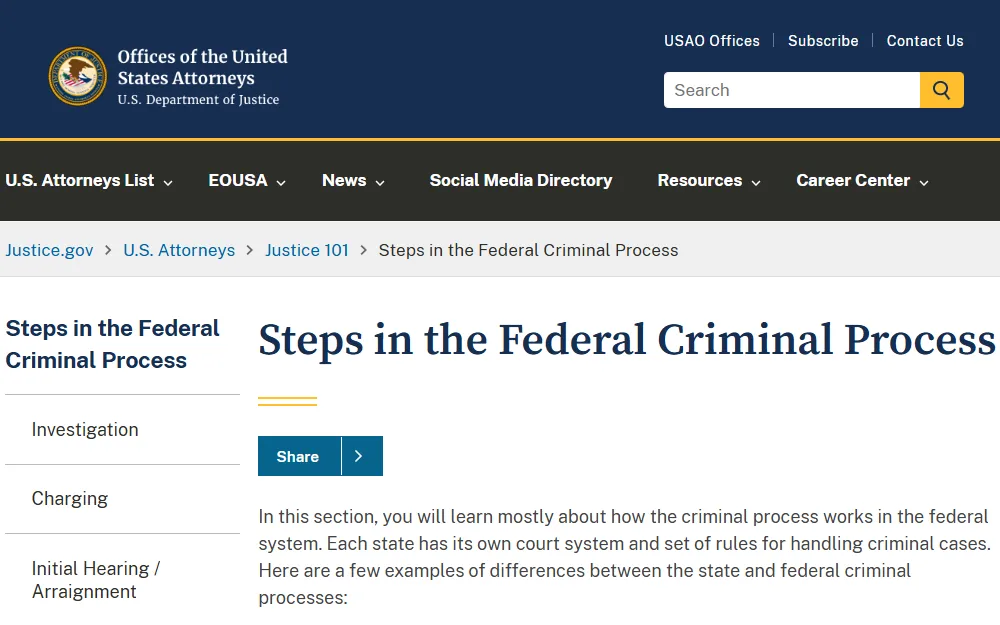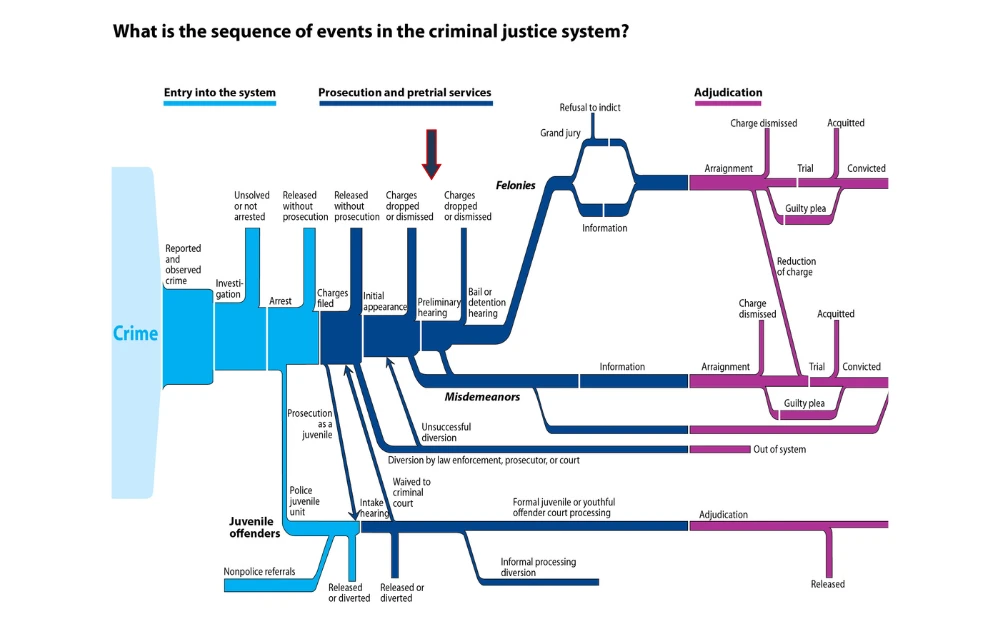
Individuals facing criminal prosecution may be concerned or worried, but while uncommon, the good news is that there is a chance for charges to be dropped during an arraignment hearing — and sometimes even before or after, depending on the situation.
An arraignment hearing is the formal beginning of a criminal proceeding where the prosecution reads the defendant’s charges and is given the opportunity to plead. While dropping charges is possible around this time, it’s unusual.
This brief resource walks you through the arraignment process, explains how charges may be contested in court, and underlines the importance of a competent legal representation.
Understanding Arraignment Hearings: What To Expect
If you’re not very familiar with an arraignment hearing, it’s important to know its role in the legal process. This section breaks down what happens during the hearing.
An arraignment hearing is one of the first steps taken after an arrest that starts the criminal justice process.1 Here are the things you generally need to expect to happen during the hearing: you’ll be formally charged and will be requested to enter a plea (guilty, not guilty, or no contest). A public defender will be appointed by the court if you don’t already have a lawyer and can’t afford one.
Your bail or bonds will be addressed (conditions, amount, etc.), court dates will be set – including motions (a formal request for a ruling) and pretrials – and you’ll be informed of your legal rights as a defendant, as the judge will explain the legal process.2

Now that you know the events that typically take place during an arraignment, let’s explore whether charges can be dropped during this stage of the legal process, along with the role of the prosecutor and the judge.
Is It Possible for Charges To Be Dropped at the Arraignment Hearing?
Before anything else, it’s important to know the differences between having your charges dropped and having them dismissed.
When charges are dropped by the prosecutor, it’s possible you’ll face the same charges against you if they find strong new evidence. On the other hand, getting charges dismissed is more commonly done by the court or judge. Your case can be dismissed with prejudice (meaning the case is prohibited from being reopened) or without prejudice (meaning it maintains the potential to be brought back to court).4, 5
Now, charges are usually dropped before the initial court hearing to avoid unnecessary legal proceedings. Getting charges dropped during arraignment isn’t common, but is possible.
This can be due to the legal reasons outlined below.
- Lack of probable cause: This means there is no factual basis or reasonable belief to press charges.
- Insufficient evidence: The evidence presented is unacceptable in court or irrelevant to the crime — unable to prove anything.
- Violation of defendant’s rights: The defendant’s constitutional rights were violated during the arrest or investigation.
- Fault in legal proceedings: There were mistakes with the legal steps taken before the case was brought to court.
- Victim’s Request: The prosecutor may drop charges if the plaintiff doesn’t want to pursue the case. However, there’s a no-drop policy in domestic violence cases in which the prosecutor can still proceed with the trial even without the victim’s cooperation.
- Re-evaluation of the case: The prosecution decides to drop charges after new evidence is presented or case facts are re-evaluated and find that the dismissal of charges is what’s appropriate to do.
There are also situations where a judge may dismiss criminal charges at an arraignment; the next section lays the factors that could lead to such a decision.
Can a Judge Dismiss Charges During an Arraignment Hearing?
It doesn’t happen a lot, but a judge can dismiss charges at an arraignment hearing with similar reasons as the previous section. Additionally, here are other factors that might lead a judge to dismiss charges:
- The defense party files a motion to dismiss and the judge approves.
- The charges don’t meet legal requirements (as a result of misinterpretation or misapplication of a law).
- The prosecution fails to appear, doesn’t provide evidence, or didn’t follow proper procedures.
- The crime occurred in a different jurisdiction or the court doesn’t have the authority to hear the case. For example, a federal crime being brought up in a state court.
- The time limit for filing charges for a crime (statute of limitations) has expired.
- The defendant has been tried for the same crime previously (also known as double jeopardy).
Remember, the government bears the burden of proof.6 Meaning, they’re the ones who need to prove the defendant’s guilt. So, these situations call charges to be dismissed during an arraignment— or any time before or after.
If the charges are dropped, the process is over. However, if they aren’t, you must prepare for the next steps in trial.
What Comes Next After Charges Are Dropped (and What If They Aren’t)?
Naturally, the case ends when the prosecution drops charges. If that happens, there won’t be a trial at all and the defendant is released from custody. However, depending on the jurisdiction, these dropped charges may still reflect on the defendant’s criminal record.
For instance, certain states automatically seal any charges that didn’t result in conviction, like California, under the Clean Slate Act. For federal cases, expungement commonly requires a judge’s order.
If the charges are not successfully dropped during the arraignment, the trial process continues.7 On the bright side, the defense party can still file motions to dismiss charges, negotiate a deal with the prosecutor, or consider diversion programs for first time offenders or if the offense is minor.2, 8 This can involve probation or community service instead of criminal conviction.

Depending on the state, you can conveniently see progress on cases or check if there are still charges against you or someone you know throughout the process. For example, you can refer to the tutorial on finding Texas arrest and criminal data. You can do the same for other states.
Whether charges are dropped or not, the arraignment is just the beginning, and creates the conditions for the upcoming legal proceedings. This includes potential release conditions and bail amounts.9
Note: Processing bail can differ for each state. For instance, you can check the CA arrest and criminal records lookup instructions if you’re expecting a trial in California and want to know how you can post bail in the meantime. At the federal level, bail is dependent on the case and defendant.
During this whole journey, you might notice some key actions only a defense lawyer can fulfill. Their importance in getting your charges dropped is crucial, and will be discussed further in the next section.
How To Advocate for Charge Dismissal at an Arraignment (Importance of Strong Legal Representation)
An expertly skilled lawyer is of utmost importance when advocating for charge dismissal at an arraignment, and is strategic to its core — needing you to turn to the right paths.
Here’s how a strong legal representative can help you with their skills, knowledge, and expertise:
- Identifying weak points of the prosecution’s case and reviewing evidence. A skilled attorney can review case facts (e.g. evidence, procedural actions, reports, etc.) to reveal weak points and search for any grounds for dismissal.
- Ensuring your rights are upheld as a defendant. Knowledgeable of the law, a lawyer can guide you and ensure that your rights aren’t being violated.
- Presenting strong and compelling arguments for dismissal during the arraignment. Attorneys can formulate and lay out strong arguments backed by case facts, precedents — legal decisions made in previous cases that can be helpful in informing future decisions — and the defendant’s previous criminal records, or the lack thereof.
- Filing motions to dismiss charges. If any grounds for dismissal are found, the defense party may file a motion to dismiss charges (arguing insufficient evidence, legal process errors, or other valid reasons).10
- Negotiating with the prosecution. A strong defense lawyer can also enter into negotiations with the prosecution even before the arraignment— leading to either reduced or dismissed charges.8
- Setting case strategies. The expertise of a lawyer allows them to have wider perspective and, consequently, to come up with strategies that may help in case the charges aren’t dismissed at an arraignment.
Having a good defense attorney by your side is important to effectively challenge a case. This leads to better outcomes for you — a case dismissal at best, avoiding unnecessary trials.
All said, it’s noteworthy that charges actually can be dropped at an arraignment hearing; it doesn’t happen all the time, but it’s possible when there are procedural errors, insufficient evidence, or other valid legal reasons. This whole process can be complicated, so it’s important to consult with an attorney who can advocate for your best interests.
References
1U.S. Department of Justice, Offices of the United States Attorneys. (n.d.). Initial Hearing / Arraignment. Retrieved December 13, 2024, from <https://www.justice.gov/usao/justice-101/initial-hearing>
2U.S. Department of Justice, Offices of the United States Attorneys. (n.d.). Pre-Trial Motions. Retrieved December 13, 2024, from <https://www.justice.gov/usao/justice-101/pretrial-motions>
3U.S. Department of Justice, Offices of the United States Attorneys. (n.d.). Steps in the Federal Criminal Process. Retrieved December 13, 2024, from <https://www.justice.gov/usao/justice-101/steps-federal-criminal-process>
4Legal Information Institute (LII). (2020, November). Dismissal With Prejudice. Retrieved December 13, 2024, from <https://www.law.cornell.edu/wex/dismissal_with_prejudice>
5Legal Information Institute (LII). (2020, November). Dismissal Without Prejudice. Retrieved December 13, 2024, from <https://www.law.cornell.edu/wex/dismissal_without_prejudice>
6United States Courts. (n.d.). Criminal Cases. Retrieved December 13, 2024, from <https://www.uscourts.gov/about-federal-courts/types-cases/criminal-cases>
7U.S. Department of Justice, Bureau of Justice Statistics. (2021, June 3). The Justice System. Retrieved December 13, 2024, from <https://bjs.ojp.gov/justice-system>
8U.S. Department of Justice, Offices of the United States Attorneys. (n.d.). Plea Bargaining. Retrieved December 13, 2024, from <https://www.justice.gov/usao/justice-101/pleabargaining>
9U.S. Department of Justice. (n.d.). 26. Release And Detention Pending Judicial Proceedings (18 U.S.C. 3141 Et Seq.). Retrieved December 13, 2024, from <https://www.justice.gov/archives/jm/criminal-resource-manual-26-release-and-detention-pending-judicial-proceedings-18-usc-3141-et>
10Legal Information Institute (LII). (2023, July). Motion to Dismiss. Retrieved December 13, 2024, from <https://www.law.cornell.edu/wex/motion_to_dismiss>
